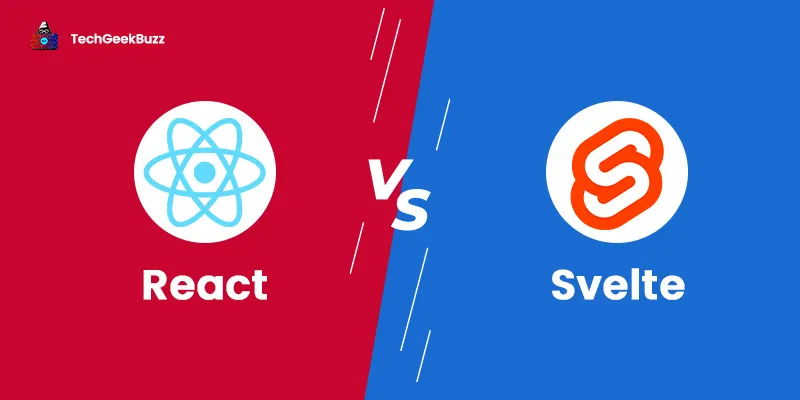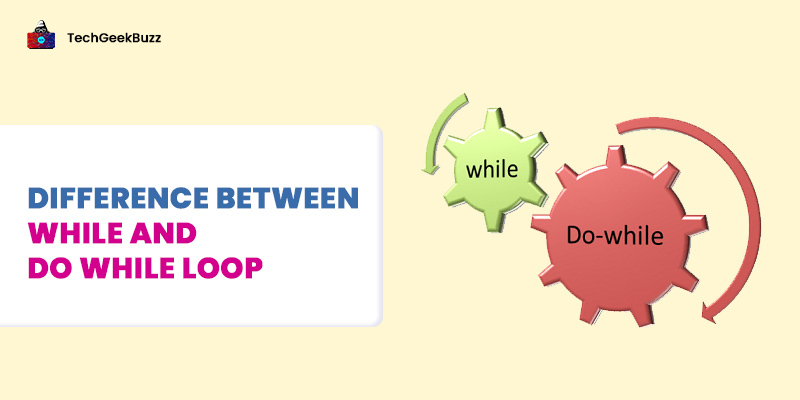React and Svelte are two popular front-end JavaScript-based technologies in use today. While React is a library for creating user interfaces for single-page and mobile applications, Svelte is a framework that operates much like a compiler, assisting developers in building web applications.
There is often confusion among developers regarding the decision between React and Svelte. Svelte is pretty new in the web development domain, while React has been ruling the market for a long time.
To help in your decision between React and Svelte, we have created this article, listing all the major differences between the two to find out the best one that fits your project requirements.
So, let us get started!
What is React?
React is an open-source, widely utilized front-end JavaScript-based library for creating interactive user interfaces by leveraging UI components. It is often referred to as ReactJS and React.js. It serves as the foundation for the development of mobile, server-rendered, and single-page applications .
This library is primarily used for managing the view layer in the MVC architecture . However, it is essential to note that React is only associated with statement management and its rendering to DOM. For client-side functionality and routing, you need to consider other libraries.
Moreover, this library lets you create your own custom encapsulated components and compose them to create complex user interfaces (UIs).
History
A software engineer at Meta (formerly Facebook) named Jordan Walke designed the React library. He first made available FaxJS, a React prototype. This concept originated with XHP, an HTML component library for PHP. In 2011, he deployed the first prototype on Facebook, and in 2012, on Instagram. Later, at JSConf US in 2013, he made it open-source.
This React library then formed a basis for React Native, a framework for developing cross-platform mobile applications. In 2017, the company then decided to change React’s rendering system and came up with React Fiber, which included a collection of algorithms for rendering. This new rendering system did not change the syntax for programming. Instead, it changed the way of executing the syntax.
In 2017, the company launched the new version of React, React 16.0, into the market. React 17.0 was the first major release without making any modifications to React developer-facing API. The latest and the most stable version of React is React 18.1, with more bug fixes and performance improvements.
Features
The following is a list of some remarkable features of React:
-
JSX
It is an acronym for JavaScript Syntax Extension, which is a combination of HTML and JavaScript. It lets you insert JavaScript objects into HTML tags. Since browsers do not support JSX, a Babel compiler transcompiles JSX code into JS code. You can easily learn JSX if you know HTML and JavaScript.
-
Virtual DOM
DOM is an acronym for Document Object Model, which is a programming interface for HTML and XML documents. It treats HTML and XML documents in the form of a tree structure. While you use JavaScript frameworks, they update the entire DOM whenever you make changes to your website or web application, which results in slow performance.
This is not the case with virtual DOM. Virtual DOM or VDOM creates a copy of real DOM. When you make any change to your web application, VDOM updates first and compares itself with the real DOM for differences. Once it examines the differences, the real DOM updates the only part of the web application that has changed recently.
-
One-Way Data Binding
As its name implies, data in React flows in only a single direction. It takes the top to bottom approach, i.e., the parent component to the child component. It is not possible for the properties in child components to return data to their parent components. However, child components can communicate with their parent components to modify the states based on the input provided. Such one-way data binding ensures speed and modularity.
-
Extension
You can extend the functionality of React to create interactive UIs for web applications. It supports extensions for React Native, Flux, Redux, and many others.
-
Conditional Statements
JSX lets you embed conditional statements in your code. As per the conditions you specify using JSX, the browsers display the data accordingly.
-
Reusable Components
When you create a UI using React, it divides a web page into multiple components, where each has its own logic and structure. You can reuse any of the components as and when required.
Pros
Some of the remarkable benefits of React are as follows:
- React is easy to learn and use. If you have sound knowledge of JavaScript, you find it is even easier to learn.
- It lets you create interactive user interfaces with minimal coding.
- Virtual DOM enhances the performance of your websites or web applications by creating a replica of the actual DOM.
- As it is an open-source library, it has a huge community. A lot of developers across the globe contribute their skills and help newbies with their problems while using React.
- With React, you can reduce your website’s load time and boost the rendering speed, which makes it SEO-friendly.
Cons
The following are the significant downsides of React:
- The React environment evolves continuously, and hence, many developers find it difficult to stay up with the latest ways of using React.
- As React updates constantly, there is no comprehensive and proper documentation available.
- It is in charge of only state management and rendering the state to DOM.
- Many new developers find JSX challenging to learn as it is new to them.
What is Svelte?
Svelte is a free and open-source, component-based front-end framework but works more similar to a compiler. It is not a JavaScript library that applications can import into their source code. Instead, it is more like a compiler that compiles HTML templates into specialized code that has the capability to manipulate DOM directly. This results in better client performance.
This compiler compiles the application code and converts it into vanilla JavaScript. Whenever you modify the data associated with UI elements, Svelte inserts calls into the application code to automatically recompute data and re-render UI elements. This results in reduced overhead that is generally associated with virtual DOM.
History
Svelte is a successor to Ractive.js , a template-driven UI library, both developed by Rich Harris. In 2016, Rich Harris released the first version of Svelte, which he developed in JavaScript. Basically, the first version was a combination of Ractive and a compiler.
Later in 2018, Harris released the second version of Svelte. He released the second version to correct all the mistakes found in the first version. In 2019, he then developed the third version of Svelte in TypeScript.
Features
The primary features of Svelte are as follows:
-
Less Code
When working with Svelte, you need to write fewer lines of code, which reduces time, improves readability, and reduces bugs. Svelte makes it possible because of TypeScript. Let us see a simple ‘Hello World’ program in Svelte.
<script>
let name = "World"
</script>
<h1>Hello {name}!</h1>
The same code would be 30 to 40% larger when written in React and Vue. In addition, Svelte makes it easy to change the local state of the variable just by using the assignment operator (=). On the contrary, you need to use the useState hook in React, which makes the code heavier.
-
No Virtual DOM
Like React, Svelte does not leverage virtual DOM (VDOM). As a compiler, Svelte does not require you to load the library to the browser and run the code. Instead, it requires you to just load the .js file on the page to render the application or website. Moreover, Svelte performs all the object changes at compile time, which helps in reducing the overhead the virtual DOM generates.
-
Purely Reactive
Svelte is purely reactive. When you want variables to be updated and recalculated based on other variables, responsive statements come in handy. You simply need to add $ as a prefix to the variable that you want to be reactive to.
-
Global State Management
While working with React, you need to use third-party tools to extend its functionality for routing and client-side functionality. But, this is not the case with Svelte. What you need to do is to define a variable as a writable or readable store and leverage it in any .svelte files with a prefix as ‘$.’
-
Automatic Component Export
In general, when you wish to export one component to another, you have to write a separate code for it. However, in Svelte, there is no need to write a dedicated code for exporting components. Instead, the .svelte components are exported by default automatically. Also, they are always ready to be imported to other components.
Pros
Some of the significant advantages of Svelte are as follows:
- Since Svelte is a clean and neat framework without any unnecessary additions, it makes it easy for developers to write code.
- As Svelte requires less coding, it results in fewer bugs and improves code readability.
- Svelte is replete with robust effect modules, such as svelte/transition, svelte/animation, and svelte/easing.
- It does not require any virtual DOM, which improves the performance of your website or web application by reducing the overhead VDOM generates.
Cons
- Svelte does not allow you to develop cross-platform applications. For example, if you are developing an application for a desktop, you need to rewrite the code from scratch for the mobile application.
- Since Svelte is a new player in the web development market, there are not many development tools for Svelte available.
- It has a small community, unlike React.
React vs Svelte - A Detailed Comparison
Now, let us move on to discussing the detailed differences between React and Svelte.
1. React’s Virtual DOM vs Svelte’s Compiler
React leverages Virtual DOM to interpret the source code in the application at runtime. To supervise and update DOM, React uses an amount of overhead code that will run on the browser’s JavaScript engine. VDOM constantly observes the code for any changes and uses the best possible way to reflect those changes in the real DOM.
On the contrary, Svelte, working more like a compiler, compiles the application source code into Vanilla JavaScript. This means that the overhead framework code will not run the browser when the source code is running in the DOM. During the compiler time, Svelte converts components into efficient code that updates DOM directly.
2. React vs Svelte - Performance
In terms of performance, Svelte outperforms React as well as other front-end frameworks, like Angular and Vue. It offers blazing fast performance because of its ability to interpret the source code at the compile time rather than run time.
Additionally, Svelte compiles your application code into Vanilla JavaScript. Hence, browsers have to do less work at run time because they do not have to process the framework code, which significantly improves the speed and performance.
Moreover, the absence of virtual DOM is another reason for Svelte’s high performance. The compiler of Svelte keeps track of variables, and as a variable changes, it updates the component associated with that variable.
3. React vs Svelte - Ease of Use
While choosing any tool, it is obvious that everyone considers its ease of usability. When it comes to ease of use, Svelte gains an edge over React. React requires you to learn its syntax called JSX (JavaScript Syntax Extension), which can be challenging for beginners.
Meanwhile, Svelte is based on most of the classic web development models of JavaScript. Also, most parts of Svelte are plain HTML, CSS, and JavaScript, which is easier to understand and code.
4. React vs Svelte - Developer Experience
Svelte requires developers to achieve the maximum features of an application with less code. In React, you need to write a number of lines to achieve the same features of the application.
Also, Svelte components have the ability to export to others automatically; there is no need to write a dedicated set of instructions. In React, you need to write code for exporting one component to another.
Another advantage of Svelte over React is that the former does not require third-party libraries for effects and animations, as it is replete with built-in modules for the same.
With all the above benefits, Svelte significantly reduces the development work of developers and enhances their experience.
5. React vs Svelte - Server-Side Rendering (SSR)
Server-side rendering refers to the ability of an application to convert HTML files into a completely rendered HTML page for the browser. For SSR, React leverages the Next.js framework , which is a popular one for creating SSR applications. On the other hand, Svelte leverages SvelteKit, which is a full-stack framework for developing web applications.
Both Next.js and SvelteKit offer features, including routing, static-site generation, API endpoints, SSR, and layout. However, Next.js outperforms SvelteKit in terms of images. The Image component of Next.js does everything, from compressing and optimizing images to itself; developers don’t have to worry about images.
6. React vs Svelte - Popularity
Though Svelte gains an edge over React in terms of performance, speed, ease of use, and developer experience, React is still a popular JavaScript-based UI library. Backed by Meta, it has a huge community of developers that offers strong support. Meanwhile, Svelte is a pretty new front-end technology and is giving a strong rivalry to its counterparts by gaining traction at a greater pace.
React vs Svelte - A Head-to-Head Comparison
Here is a table that highlights major differences between React and Svelte:
|
Parameters |
React |
Svelte |
|
Developed by |
Jordan Walke in 2011 |
Rich Harris in 2016 |
|
Based on |
Virtual DOM |
Compiler |
|
Ease of Use |
Complex than Svelte |
High |
|
Performance |
Less as compared to Svelte |
High |
|
Server-Side Rendering |
Next.js |
SvelteKit |
|
Popularity |
High |
Less as compared to React |
|
Bundle Size |
The zipped version of React is 42.2KB, along with DOM. |
The zipped version of Svelte is 1.6KB. |
|
Code Readability |
Lower than Svelte |
Extremely high |
React vs Svelte - Which One is Better?
From the above discussion, we can conclude that Svelte is far better than React in many terms, such as performance, ease of use, and developer productivity. Svelte is a beginner-friendly front-end framework that lets developers create web applications smoothly and quickly that provide high performance.
However, React still remains a popular and go-to library for creating responsive UIs for server-side and single-page applications. As Meta maintains it, React is still one of the best tools among web developers as it supports developing cross-platform applications.
If your requirements are developing complex and large-scale web applications, choosing React will help you. On the flip side, Svelte is a go-to option for creating fast and simple web applications.
Conclusion
Here ends our discussion on React vs Svelte. Though Svelte is a new framework in the market, Harris developed it after using other popular frameworks, such as Angular and Vue. Many seasoned developers are finding Svelte a game-changer and opting for it to develop high-performance web applications. Meanwhile, React is a flexible library that supports component reuse and helps developers create UIs and applications for multiple platforms.
Ultimately, the choice between React and Svelte depends upon an individual’s preference and project requirements.
People are also reading:





Leave a Comment on this Post